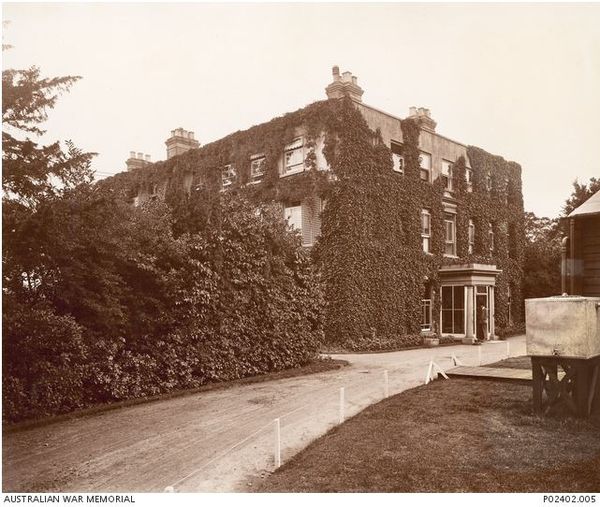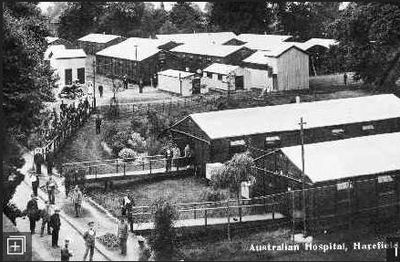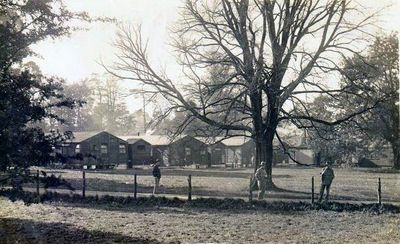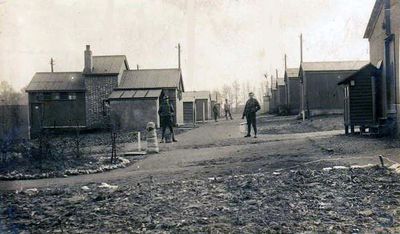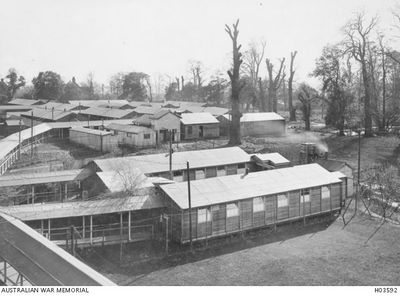Difference between revisions of "1st Australian Auxiliary Hospital"
From Our Contribution
(→Soldier Patients) |
|||
| Line 67: | Line 67: | ||
*[[James Barber]] Sep 1916 | *[[James Barber]] Sep 1916 | ||
*[[George Henry Aspinall]] 25 Jun 1917 - 3 Jul 1917 | *[[George Henry Aspinall]] 25 Jun 1917 - 3 Jul 1917 | ||
| + | *[[Albert Victor Berry]] 27 Aug - 3 Sep 1917 | ||
*[[David Forbes Abernethy]] 17 Sep 1918 | *[[David Forbes Abernethy]] 17 Sep 1918 | ||
[[Category:Hospitals]] | [[Category:Hospitals]] | ||
Revision as of 23:28, 19 November 2017
General Information
Opened 19 January 1915 at Luna Park, Cairo, Egypt. Closed 10 July 1916, and designation transferred to Harefield establishment.
In November 1914, Mr and Mrs Charles Hillyard-Leake (Australians resident in the UK) had offered the property known as "Harefield Park", Harefield, Middlesex, to be used as a home for convalescent wounded soldiers of the A.I.F. Their offer was accepted in December 1914.
At the time it was accepted, authorities estimated that the house would accommodate 50 soldiers in winter and up to 150 during spring and summer. At the height of its use the property accommodated over 1,000 beds.
The first staff for this hospital left Australia on HMAT A54 Runic in April 1915 and comprised 1 Captain Commanding Officer and his staff, along with a Matron and five nurses. Staff levels in 1916 were: Medical Staff of 1 Lieutenant Colonel, 5 Majors, 12 Captains, 2 Hon Lieutenant Dentists; Nursing Staff of 1 Matron; 20 Nursing Sisters; 36 Staff Nurses; 6 Masseuses (male or female); Administration/Support Staff of 1 Sergeant Major, 15 Sergeants/Staff Sergeants, 10 Corporals, 9 Privates, and a large number of volunteers.
The hospital was tasked with providing a rest home to allow soldiers of all ranks to recuperate after sickness or injury, and as a depot for collecting invalids for return to Australia. However, in time all hospital functions were performed, and by 1918 it was a centre for eye, ear, nose and throat diseases. Mostly they were surgical cases and it was possible for special attention to be given to amputees before their return to Australia.
The war hospital closed on 31st December 1918, but today the site is home to Harefield Hospital, one of the top cardiac hospitals in the world. Links to its Australian past remain, with pictures of the men that were treated at the hospital in the Anzac Centre, opened in 2003 and home to the Out-Patients Department, Echo-cardiology, the transplant clinic and two cardiac operating theatres. In addition the annual Anzac Day service is held at St. Mary’s church where 112 Australian servicemen from the First World War are buried.
At its peak there were more than 40 buildings in use. A small magazine titled Harefield Park Boomerang was regularly produced (a 2 volume bound collection of these are held at the Australian War Memorial Library).
Staff
- Edith Marion Wilson 22 Nov 1917 to 4 Nov 1918
Soldier Patients
- James Barber Sep 1916
- George Henry Aspinall 25 Jun 1917 - 3 Jul 1917
- Albert Victor Berry 27 Aug - 3 Sep 1917
- David Forbes Abernethy 17 Sep 1918
